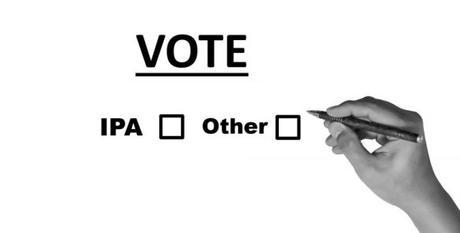
Pliny the Elder's reign is over. Since 2009, the beloved double IPA has sat atop the annual "best beer" poll held by Zymurgy magazine, but no longer.
Over that same period of time, Bell's Two Hearted has been Pliny's #2. Always a bridesmaid, never a bride? No more.
The magazine of the American Homebrewers Association released this week its new rankings as voted on by AHA members, who were able to choose up to 20 of their favorite commercial beers available for purchase in the United States through an online voting system. The flip-flop of Pliny the Elder and Two Hearted isn't the only thing worth paying attention to, however.
Per annual tradition, let's take a walk through the results.
The collection of styles represented for 2017's list shows we've hit something of a plateau in terms of diversity. The usual suspects top the list (thanks, INSATIABLE ANIMALS) and, as I have in the past, I've lumped in an American Pale Ale like Zombie Dust into the IPA category because this is my blog and I'll cry tears of lupulin if I want to.
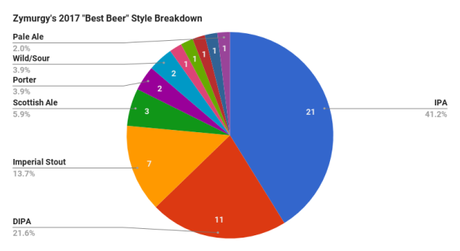
Ho-hum. IPA rules the land. When you think about it, 11 different styles across 51 beers (thanks, ties!) is pretty incredible given drinker proclivity toward IPA everything, so I wonder if things will ever change that much from here. For example, here are 2016 and 2017 style breakdowns for comparison:
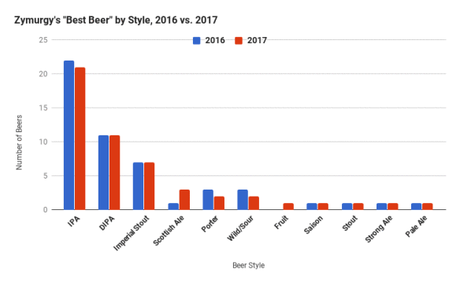
Almost identical, but REALLY different from what 2017's styles look like compared to 2011, the first year the AHA shifted polling to only include American brands:
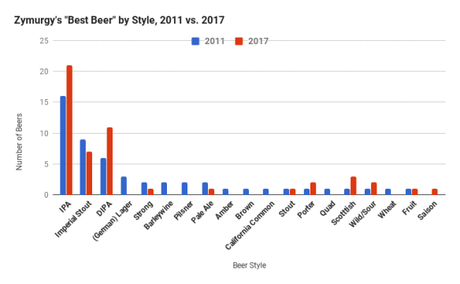
That's *18* styles from 2011, and I even looped a couple of lagers rooted in Germany into one generic category just to keep things from getting out of hand.
This change interests me not just for consolidation around a specific set of styles - apparently we really know what we want - but doing so while also having the widest array of choices we have ever had. An amber or brown ale no longer show up on Zymurgy's list, but there are also a really high number of ambers and browns being made right now with all sorts of flavor options. If voters wanted to, I imagine there may be a brand made to those styles that could get attention, but they now seem more antiquated than anything. We still turn to IPA and imperial stout. It doesn't have to be a bad thing, but it's still a thing all the same.
Best of all, I'd take these responses with a much higher probability of representing the public at large over a Beer Advocate or RateBeer "best of" list, as these AHA members vote highly for a wide array of beers that are commonly found and also really, really good. If this is to be believed, the narrowing of preference toward a smaller set of styles could be telling for breweries. You don't have to go all over the map with what you make ( we know how authenticity can play for one-offs) because about a dozen styles of beer are really interesting to drinkers.
Speaking of which, just because I love you INSATIABLE ANIMALS so much, it's been clear for years what butters your bread or double-dry hops your beer or whatever:
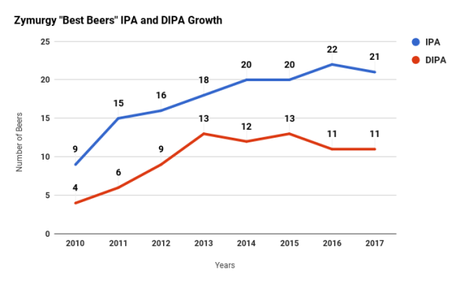
To emphasize this point even more, half the dozen new beers included in 2017 that weren't on 2016's list, we have Wicked Weed's Pernicious IPA, Alchemist's Focal Banger IPA and DIPA's like Fat Head's Hop Juju and Melvin 2×4. Hope you've got some enamel left on your teeth.
Even if you do, you're liver is still pissed.
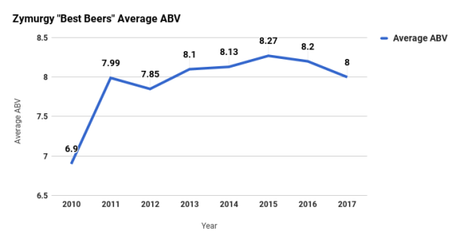
Yes, we can point at the average ABV dropping by a quarter of a percent in the last three years, but the average alcohol content across 51 beers (thanks, ties!) is still a whopping 8%. People can talk about trends of lower alcohol beer all they want, but the stuff that gets people excited is still pretty high octane. A reminder that the most recent analysis to determine the average strength of Brewers Association-defined "craft" is 5.9% ABV, and 44 of 51 beers listed in 2017 were above that threshold. Only two - Founders All Day IPA (4.7%) and New Glarus Belgian Red (4%) - were under 5%.
To poke at this a little more, let's separate the top and bottom-"25" of these lists, because as we see with so many "best beer" compilations, the top half rarely changes much year-to-year thanks to baked in perceptions and expectations. Most fluctuation will take place at the bottom of these lists, with some beers moving in and out. I like to pay extra attention to that half, because finding new beers is always fun, especially for quantitative purposes:
That top-25 ABV takes a bigger fall, but mostly because a few "big" beers like Arrogant Bastard and Backwoods Bastard and others not named bastard dropped a few spots. Even still, the consistency of the bottom-25 is what gets my attention, because that's where the most change is happening year-to-hear, and yet ABV still stays the same while 55-60% of styles stay IPA or DIPA.
If those numbers weren't enough to get you excited, now comes the fun(?) part.
In year's past, some basic idea of trends and interests came forth from analyzing Zymurgy's list. In 2014, it was trying to see if there was anything beyond the commitment toward "heritage" styles. In 2015, voters doubled-down on love for IPA. Last year, there seemed to be some small rebellion against classic brands that dominated a few years prior.
For 2017, there's a clearer indication of what "new" means to people.
Dogfish Head has been a good example of this in recent years, as their "Minute" lineup of IPAs has tumbled downward:
Similarly, it's been an odd combination of rankings for Sierra Nevada's beers, which have a strong hold on AHA members for both quality and nostalgic reasons, I'm sure. I'm including Celebration because hot damn, it's strong. No other beer has seen the same kind of fall and rise:
Stone IPA and Ruination have had a tough go over the years, and Dale's Pale Ale, while still on the list, went from a high ranking of 14 in 2012 to 43 the past two years. North Coast Old Rasputin, one of the best imperial stouts in the world - and you can get it for $10! - has gone from a high of #10 in 2012 to 38 two years in a row.
So an odd collection of beers got my attention this time around, not because they were new in the sense they didn't exist before, but they're new in that they're continually new to people. A first batch for example:
KBS has its rarity and reputation to rely on, and anecdotally seems to have higher production levels the last couple years. Which, along with these other three, caught my eye. Aside from being good beers, what do they have in common? Why would they be making a jump in recent years? Is it expansion?
Boulevard, Cigar City and Founders have all been increasing their distribution footprint, which means that in addition to providing these quality beers, more people are becoming exposed to them. Outside of its hometown of Kansas City, Tank 7 is Boulevard's best-selling beer, according to Jeremy Danner, Ambassador Brewer for Boulevard. In new markets ( which continue to grow), it's now a top beer for the company. Even in today's diverse drinker world, an 8.5% ABV, Belgian-style farmhouse ale doesn't scream "top seller" among new drinkers.
Except it does! And it's doing so in places where people use it as their first exposure to Boulevard!
This is complementary of an assumption I've continually made about why Pliny the Elder conquered Zymurgy's list:
Due to Pliny the Elder's very limited distribution (CA, CO, OR and Philadelphia) the number of people who have access to this beer is very limited. It may be a popular choice on beer trading forums, but I can't help but wonder how much its reputation, historical place with beer drinkers and overall hype keeps it at No. 1, especially when hundreds of thousands of words have been written about how it's really not as good as you think.
Could other beers be moving up the list because more people are actually getting to try them? Or try them consistently? Rather than relying on hype, these beers could be getting their due through experience, too. While not outlandish in their move up the lists, I also thought about these four beers, which have appeared since 2015:
New Belgium has been around for a long time on a national basis, but they're finally fully national and also getting their flagship sour beer in front of people for the first time. Deschutes has carefully expanded and has already stretched into Virginia and North Carolina. Head Hunter gets a boost because of Fat Head's growing brewpub footprint - now with four locations - and Hop Juju made its first appearance on the list in 2017. Tree House is, well, hyped. A New England IPA on a Zymurgy list says a lot about the transition of "old" to "new" guard.
Which brings us back to the flip-flop of Pliny the Elder giving up this year's top spot to Bell's Two Hearted. It's not a big deal for news as much as a symbolic one. Bell's has itself been expanding rapidly, led by its flagship IPA, which accounts for a little over 50% of sales, per latest data made available last year. Maybe this is a sign of people finally getting tired of voting for a rare double IPA to the top spot. Maybe it's an indication that more people have tasted Two Hearted and, like others, determined it to be a worthy rival to Pliny.
But most important, these changes suggest that on a national level, getting good beer in front of more people can change minds. Seems pretty straight forward, right?
While it may not to be a hit with AHA/Brewers Association crowds who prefer not to buy AB InBev, this all makes me wonder about reception for something like Elysian's Space Dust IPA, which AB InBev is using as Elysian's lead brand to enter markets. Objectively (on a crowdsourced level) it's a great beer. Goose Island IPA does well, too. Also, Golden Road's Wolf Pup.
Discussing the merits of these beers and their place as "craft" is a whole other conversation, but reach matters, and separately of these Zymurgy results, all this does make me wonder a little more about how those kind of beers will be able to attract audiences as they move across the country.
Bryan Roth
"Don't drink to get drunk. Drink to enjoy life." - Jack Kerouac

